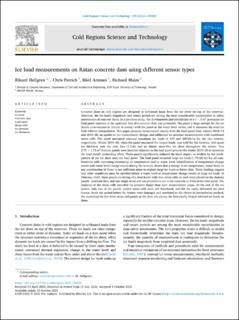| dc.contributor.author | Hellgren, Rikard | |
| dc.contributor.author | Petrich, Chris | |
| dc.contributor.author | Arntsen, Bård | |
| dc.contributor.author | Malm, Richard | |
| dc.date.accessioned | 2021-10-26T13:07:02Z | |
| dc.date.available | 2021-10-26T13:07:02Z | |
| dc.date.created | 2021-10-20T13:12:19Z | |
| dc.date.issued | 2021 | |
| dc.identifier.citation | Cold Regions Science and Technology. 2021, . | |
| dc.identifier.issn | 0165-232X | |
| dc.identifier.uri | https://hdl.handle.net/11250/2825751 | |
| dc.description.abstract | Concrete dams in cold regions are designed to withstand loads from the ice sheet on top of the reservoir.However, the ice load's magnitude and return period are among the most considerable uncertainties in safety assessments of concrete dams. In a previous study, the development and installation of a 1 × 3 m2 prototype ice load panel attached at the upstream face of a concrete dam was presented. The panel is large enough for the ice sheet's cross-section to remain in contact with the panel as the water level varies, and it measures the total ice load without interpolation. This paper presents measurement results from the load panel from winters 2018–19 and 2019–20, an update to the measurement design, and additional ice pressure measurements with traditional stress cells. The panel measured seasonal maximum ice loads of 100 and 200 kN/m for the two winters,respectively. Winter 2019–20, when the panel measured the largest loads, was mild for the location, with great ice thickness near the dam face (1.2 m) and an almost snow-free ice sheet throughout the winter. Two 2.75 × 1.75 m2 dummy panels were installed adjacent to the load panel prior to the winter 2019–20 to minimize the load panel's protruding effect. These panels significantly reduced the local impact, as evident by the crackpattern of the ice sheet near the load panel. The load panel recorded large ice loads (>75 kN/m) for all combinations with increasing/decreasing air temperature and/or water level. Identification of temperature change events and water level change events during the winters, shows that a change in air temperature, water level, or any combination of these, is not sufficient alone to explain large ice loads at R¨atan dam. These findings suggest that other conditions must be satisfied before a water level or temperature change results in large ice loads. In February 2020, three panels consisting of a steel frame with four stress cells on each were placed on the dummy panels’ upstream face, and one single stress cell was placed 6 m out in the reservoir in front of the load panel. The majority of the stress cells recorded ice pressure larger than their measurement range. At the end of the ice season, only two of the panels’ twelve stress cells were still functional, and the ice vastly deformed the steel frames. From the period before the frames were damaged and unrelated to the choice of interpolation method,the recordings | |
| dc.language.iso | eng | |
| dc.subject | Load panel | |
| dc.subject | Load panel | |
| dc.subject | Ice load | |
| dc.subject | Ice load | |
| dc.subject | Ice pressure | |
| dc.subject | Ice pressure | |
| dc.subject | Concrete dam | |
| dc.subject | Concrete dam | |
| dc.title | Ice load measurements on Rätan concrete dam using different sensor types | |
| dc.type | Peer reviewed | |
| dc.type | Journal article | |
| dc.description.version | publishedVersion | |
| dc.subject.nsi | VDP::Bygningsmaterialer: 525 | |
| dc.subject.nsi | VDP::Building materials: 525 | |
| dc.source.pagenumber | 15 | |
| dc.source.journal | Cold Regions Science and Technology | |
| dc.identifier.doi | https://doi.org/10.1016/j.coldregions.2021.103425 | |
| dc.identifier.cristin | 1947282 | |
| dc.relation.project | Norges forskningsråd: 195153 - ColdTech | |
| dc.relation.project | Andre: Swedish Hydropower Centre | |
| dc.relation.project | Norges forskningsråd: 280744 (BA-Senter Nord) | |
| cristin.ispublished | true | |
| cristin.fulltext | original | |
| cristin.qualitycode | 2 | |
